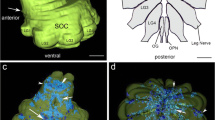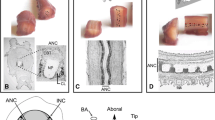Summary
Several plant lectins were used to characterize the cell-surface carbohydrates expressed on sensory ganglion cells and their central terminals in the spinal cord dorsal horn. In the rat, galactose-terminal glycoconjugates on a large subpopulation of small neurons whose central axons project to the substantia gelatinosa were demonstrated with the α-D-galactose-specificGriffonia Simplicifolia I-B4 (GSA) lectin. This neuron subset was labelled by alternative D-galactose-, N-Acetylgalactosamine-, and βGal(1,3)NAcGal-binding lectins. Similar GSA lectin reactivity was also illustrated in selected peripheral autonomic, gustatory and visceral sensory and enteric neurons, and the accessory olfactory bulb. The sensory neuron-specific isoenzyme, fluoride-resistant acid phosphatase (FRAP) co-localized with the GSA lectin, as did the monoclonal antibody (MAb) 2C5, which is directed against a lactoseries carbohydrate constituting a backbone structure of ABH human blood group antigens. In contrast, calcitonin gene-related peptide-immunoreactivity (CGRP-IR), used as a representative marker of peptidergic neurons, exhibited limited co-localization with GSA. A polyclonal anti-rat red blood cell (RBC) antibody co-localized with GSA, suggesting that lectin-reactive carbohydrates on rat sensory neurons are related to rat RBC antigens. In the human spinal cord, thel-fucose-bindingUlex europaeus-I (UEA) lectin also labelled the substantia gelatinosa; in rabbit, a small sensory ganglion cell subset and the spinal cord substantia gelatinosa was co-labelled by both the GSA and UEA lectins.
These studies illustrate significant lectin-reactive cell surface carbohydrate expression by non-peptidergic, FRAP(+) sensory ganglion cells in the rat, and provide a means for visualizing the extensive, non-peptidergic, small sensory ganglion cell subpopulations, probably including a substantial proportion of nociceptive and unmyelinated peripheral axons.
Similar content being viewed by others
References
Bariéty, J., Oriol, R., Hinglais, N., Zannetti, M., Bretton, R., Dalix, A. M. &Maudet, C. (1980) Distribution of blood group antigen A in normal and pathologic human kidneys.Kidney International 17, 820–2.
Brown, A. G. (1981)Organization in the Spinal Cord. New York: Springer-Verlag.
Dodd, J. &Jessell, T. M. (1985) Lactoseries carbohydrates specify subsets of dorsal root ganglion neurons projecting to the superficial dorsal horn of rat spinal cord.Journal of Neuroscience 5, 3278–94.
Dodd, J. &Jessell, T. M. (1986) Cell surface glycoconjugates and carbohydrate-binding proteins: Possible recognition signals in sensory neuron development.Journal of Experimental Biology 124, 225–38.
Dodd, J., Jahr, C. E., Hamilton, P., Heath, M., Matthew, W. D. &Jessell, T. M. (1983) Cytochemical and physiological properties of sensory and dorsal horn neurons that transmit cutaneous sensation.Cold Spring Harbor Symposia on Quantative Biology 48, 685–95.
Fischer, J., Klein, P. J. &Csillik, B. (1985)Ulex europaeus I lectin-binding glycoproteins in primary sensory terminals of human spinal cord. InLectins, Vol. 4 (edited byGog-Hansen, T. C. &Breborowicz, J.) pp. 117–25. New York: Walter de Gruyter.
Goldstein, I. J. &Hayes, C. E. (1978) The lectins: carbohydrate-binding proteins of plants and animals.Advances in Carbohydrate Chemistry and Biochemistry 35, 127–340.
Hamburger, V., Bruno-Bechtold, J. K. &Yip, J. W. (1981) Neonatal death in the spinal ganglion of the chick embryo and its reduction by nerve growth factor.Journal of Neuroscience 1, 60–71.
Hanfland, P., Egge, H., Dabrowski, U., Kuhn, S., Roekle, D. &Dabrowski, J. (1981) Isolation and characterization of an I-active ceramide decasaccharide from rabbit erythrocyte membranes:Biochemistry 20, 5310–9.
Huang, W. M., Gibson, S. J., Facer, P., Gu, J. &Polak, J. M. (1983) Improved section adhesion for immunocytochemistry using high molecular weight polymers ofl-lysine as a slide coating.Histochemistry 77, 275–9.
Hunt, S. P. &Rossi, J. (1985) Peptide and non-peptide containing unmyelinated primary afferents: The parallel processing of nociceptive information.Philosophical Transactions of the Royal Society of London, Series B 308, 283–9.
Hökfelt, T., Elde, R., Johansson, O., Luft, R., Nilsson, G. &Arimura, A. (1976) Immunohistochemical evidence for separate populations of somatostatincontaining and substance P containing primary afferent neurons in the rat.Neuroscience 1, 131–9.
Iggo, A. (1976) Is the physiology of cutaneous receptors determined by morphology?Advances in Neurology 4, 1–9.
Jessell, T. M. (1988) Adhesion molecules and the hierarchy of neural development.Neuron 1, 3–13.
Jessell, T. M. &Dodd, J. (1986) Neurotransmitters and differentiation antigens in subsets of sensory neurons projecting to the spinal dorsal horn. InNeuropeptides in Neurologic and Psychiatric Disease (edited byMartin, J. B., &Barchas, J. D.) pp. 111–33. New York: Raven Press.
Knyihár-Csillik, E. &Csillik, B. (1981) FRAP: Histochemistry of the primary nociceptive neuron.Progress in Histochemistry and Cytochemistry 14, 1–102.
Kruger, L., Silverman, J. D., Mantyh, P. W., Sternini, C. &Brecha, N. C. (1989) Peripheral patterns of calcitonin gene-related peptide (CGRP) general somatic sensory innervation: Cutaneous and deep terminations.Journal of Comparative Neurology 280, 291–302.
Lawson, S. N. (1979) The postnatal development of large light and small dark neurones in mouse dorsal root ganglia: a statistical analysis of cell numbers and size.Journal of Neurocytology 8, 275–94.
Lawson, S. N., Harper, E. I., Harper, A. A., Garson, J. A., Coakham, H. B. &Randle, B. J. (1985) Monoclonal antibody 2C5: A marker for a subpopulation of small neurons in rat dorsal root ganglia.Neuroscience 16, 365–74.
Light, A. R. &Perl, E. R. (1979) Spinal termination of functionally identified primary afferent fibres with slowly conducting myelinated fibres.Journal of Comparative Neurology 186, 133–50.
Lillie, R. D. (1965)Histopathologic Technique and Practical Histochemistry. New York: McGraw-Hill.
Lynn, B. &Hunt, S. P. (1984) Afferent C-fibres: physiological and biochemical correlations.Trends in Neuroscience 1, 186–8.
Mollicone, R., Davies, D. R., Evans, B., Dalix, A. M. &Oriol, R. (1986) Cellular expression and genetic control of ABH antigens in primary sensory neurons of marmoset, baboon and man.Journal of Neuroimmunology 10, 255–69.
Mollicone, R., Trojan, J. &Oriol, R. (1985) Appearance of H and B antigens in primary sensory cells of the rat olfactory apparatus and inner ear.Developmental Brain Research 17, 275–9.
Mori, K. (1986) LectinUlex europaeus agglutinin I specifically labels a subset of primary afferent fibers which project selectively to the superficial dorsal horn of the spinal cord.Brain Research 365, 404–8.
Mori, K. (1987) Specific carbohydrate expression by small-diameter subclasses of rabbit trigeminal, glossopharyngeal, and vagal afferent fibers studied with the lectinUlex europaeus agglutinin I.Neurosciences Research 4, 291–303.
Mugnaini, E. &Dahl, A.-L. (1983) Zinc-aldehyde fixation for light-microscopic immunocytochemistry of nervous tissues.Journal of Histochemistry and Cytochemistry 31, 1435–8.
Nagy, J. I. &Hunt, S. P. (1982) Fluoride-resistant acid phosphatase-containing neurons in dorsal root ganglia are separate from those containing substance P or somatostatin.Neuroscience 7, 89–97.
Nagy, J. I. &Hunt, S. P. (1983) The termination of primary afferents within the rat dorsal horn: Evidence for rearrangement following capsaicin treatment.Journal of Comparative Neurology 218, 145–58.
Nakagawa, F., Schulte, B. A. &Spicer, S. S. (1986) Lectin cytochemical evaluation of somatosensory neurons and their peripheral and central processes in rat and man.Cell and Tissue Research 245, 579–89.
Oriol, R. (1983) Immunofluorescent localization and genetic control of the synthesis of the ABH and Lewis antigens. InRed Cell Membrane Glycoconjugate and Related Genetic Markers (edited byCartron, J. P., Rouger, P. &Salmon, C.) pp. 139–48. Paris: Librairie Arnette.
Oriol, R., Cooper, J. E., Davies, D. R. &Keeling, P. W. N. (1984) ABH antigens in vascular endothelium and some epithelial tissues of baboons.Laboratory Investigation 50, 514–8.
Panjwani, N. &Baum, J. (1988) A histochemical comparison of human corneal stromal glycoconjugates with eight other species.Histochemistry 89, 41–5.
Perl, E. R. (1983) Characterization of nociceptors and their activation of neurons in the superficial dorsal horn: First steps for the sensation of pain.Advances in Pain Research Therapy 66, 23–51.
Plenderleith, M. B., Cameron, A. A., Key, B. &Snow, P. J. (1988) Soybean agglutinin binds to a subpopulation of primary sensory neurones in the cat.Neuroscience Letters 86, 257–62.
Ralston, H. J., Light, A. R., Ralston, D. D. &Perl, E. R. (1984) Morphology and synaptic relationships of physiologically identified low-threshold dorsal root axons stained with intra-axonal horse-radish peroxidase in the cat and monkey.Journal of Neurophysiology 51, 777–92.
Rambourg, A., Clermont, Y. &Beaudet, A. (1983) Ultrastructural features of six types of neurones in rat dorsal root ganglia.Journal of Neurocytology 12, 47–66.
Regan, L. J., Dodd, J., Barondes, S. H. &Jessell, T. M. (1986) Selective expression of endogeneous lactosebinding lectins and lactoseries glycoconjugates in subsets of rat sensory neurons.Proceedings of the National Academy of Sciences (USA) 83, 2248–52.
Réthelyi, M. (1977) Preterminal and terminal arborizations within substantia gelatinosa of cat spinal cord.Journal of Comparative Neurology 172, 511–28.
Silverman, J. D. &Kruger, L. (1987a) Botanical lectins as highly specific probes for visualization of peripheral non-peptidergic nociceptive axons.Society for Neuroscience Abstracts 13, 778.
Silverman, J. D. &Kruger, L. (1987b) An interpretation of dental innervation based upon the pattern of calcitonin gene-related peptide (CGRP)-immunoreactive thin sensory axons.Somatosensory Research 5, 157–75.
Silverman, J. D. &Kruger, L. (1988a) Acid phosphatase as a selective marker for a class of small sensory ganglion cells in several mammals: spinal cord distribution, histochemical properties, and relation to fluoride-resistant acid phosphatase (FRAP) of rodents.Somatosensory Research 5, 219–46.
Silverman, J. D. &Kruger, L. (1988b) Lectin and neuropeptide labeling of separate populations of dorsal root ganglion neurons and associated ‘nociceptor’ thin axons in rat testis and cornea whole-mount preparations.Somatosensory Research 5, 259–67.
Silverman, J. D. &Kruger, L. (1989) Calcitonin generelated peptide (CGRP) immunoreactive innervation of the rat head with emphasis on the specialized sensory structures.Journal of Comparative Neurology 280, 303–30.
Silverman, J. D. &Kruger, L. (1990) Analysis of taste bud innervation based on glycoconjugate and neuropeptide neuronal markers.Journal of Comparative Neurology 292, 575–84.
Silverman, J. D., Zalewski, M., Wong, S. &Kruger, L. (1988) Specific functional markers for gustatory neurons and taste bud innervation in the rat based on lectin, FRAP and CGRP.Society for Neuroscience Abstracts 14, 1168.
Solter, D. &Knowles, B. B. (1978) Monoclonal antibody defining a stage specific embryonic antigen (SSEA-1).Proceedings of the National Academy of Sciences (USA) 75, 5565–9.
Spiro, R. &Bhoyroo, H. (1984) Occurrence of α-dgalactosyl residues in the thyroglobulins from several species.Journal of Biological Chemistry 259, 9858–66.
Streit, W. J., Schulte, B. A., Balentine, J. D. &Spicer, S. S. (1985) Histochemical localization of galactosecontaining glycoconjugates in sensory neurons and their processes in the central and peripheral nervous system of the rat.Journal of Histochemistry and Cytochemistry 33, 1042–52.
Streit, W. J., Schulte, B. A., Balentine, J. D. &Spicer, S. S. (1986) Evidence for glycoconjugate in nociceptive primary sensory neurons and its origin from the Golgi complex.Brain Research 377, 1–17.
Sugiura, Y., Hosoya, Y., Ito, R. &Kohno, K. (1988) Ultrastructural features of functionally identified primary afferent neurons with C (unmyelinated) fibers of the guinea pig: Classification of dorsal root ganglion cell type with reference to sensory modality.Journal of Comparative Neurology 276, 265–78.
Sugiura, Y., Lee, C. L. &Perl, E. R. (1986) Central projections of identified, unmyelinated (C) afferent fibres innervating mammalian skin.Science 234, 358–61.
Szulman, A. E. (1980) The ABH blood groups and development.Current Topics in Developmental Biology 14, 127–45.
Tajti, J., Fischer, J., Knyihár-Csillik, E. &Csillik, B. (1988) Transganglionic regulation and fine structural localization of lectin-reactive carbohydrate epitopes in primary sensory neurons of the rat.Histochemistry 88, 213–8.
Watkins, W. M. (1980) Biochemistry and genetics of the ABO, Lewis and P blood group systems.Advances in Human Genetics 10, 1–136.
Witt, M. &Reutter, K. (1988) Lectin histochemistry on mucous substances of the taste buds and adjacent epithelia of different vertebrates.Histochemistry 88, 453–61.
Zweibaum, A., Oudea, P., Halpern, B. &C. Veyre (1966) Presence in colic glandular cells of various mammalian species of an antigen cross-reacting with human blood group A substance.Nature 209, 159–61.
Author information
Authors and Affiliations
Rights and permissions
About this article
Cite this article
Silverman, J.D., Kruger, L. Selective neuronal glycoconjugate expression in sensory and autonomic ganglia: relation of lectin reactivity to peptide and enzyme markers. J Neurocytol 19, 789–801 (1990). https://doi.org/10.1007/BF01188046
Issue Date:
DOI: https://doi.org/10.1007/BF01188046




